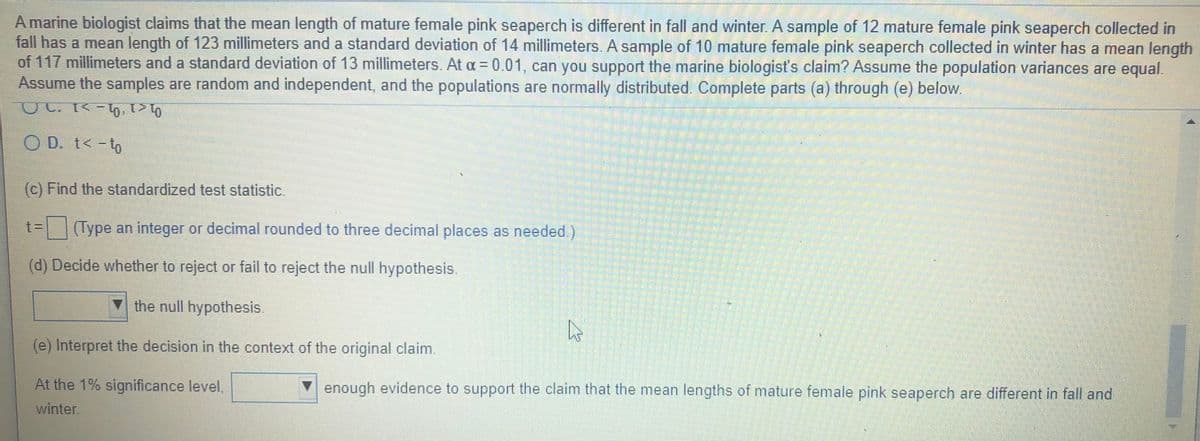A marine biologist claims that the mean length of mature female pink seaperch is different in fall and winter. A sample of 12 mature female pink seaperch collec all has a mean length of 123 millimeters and a standard deviation of 14 millimeters. A sample of 10 mature female pink seaperch collected in winter has a mear of 117 millimeters and a standard deviation of 13 millimeters. At a = 0.01, can you support the marine biologist's claim? Assume the population variances are eq Assume the samples are random and independent, and the populations are normally distributed. Complete parts (a) through (e) below. O D. t< -to (c) Find the standardized test statistic. t=(Type an integer or decimal rounded to three decimal places as needed.) (d) Decide whether to reject or fail to reject the null hypothesis. V the null hypothesis. (e) Interpret the decision in the context of the original claim. At the 1% significance level, V enough evidence to support the claim that the mean lengths of mature female pink seaperch are different in fall and winter.
A marine biologist claims that the mean length of mature female pink seaperch is different in fall and winter. A sample of 12 mature female pink seaperch collec all has a mean length of 123 millimeters and a standard deviation of 14 millimeters. A sample of 10 mature female pink seaperch collected in winter has a mear of 117 millimeters and a standard deviation of 13 millimeters. At a = 0.01, can you support the marine biologist's claim? Assume the population variances are eq Assume the samples are random and independent, and the populations are normally distributed. Complete parts (a) through (e) below. O D. t< -to (c) Find the standardized test statistic. t=(Type an integer or decimal rounded to three decimal places as needed.) (d) Decide whether to reject or fail to reject the null hypothesis. V the null hypothesis. (e) Interpret the decision in the context of the original claim. At the 1% significance level, V enough evidence to support the claim that the mean lengths of mature female pink seaperch are different in fall and winter.
Glencoe Algebra 1, Student Edition, 9780079039897, 0079039898, 2018
18th Edition
ISBN:9780079039897
Author:Carter
Publisher:Carter
Chapter10: Statistics
Section10.5: Comparing Sets Of Data
Problem 2GP
Related questions
Question

Transcribed Image Text:A marine biologist claims that the mean length of mature female pink seaperch is different in fall and winter. A sample of 12 mature female pink seaperch collected in
fall has a mean length of 123 millimeters and a standard deviation of 14 millimeters. A sample of 10 mature female pink seaperch collected in winter has a mean length
of 117 millimeters and a standard deviation of 13 millimeters. At a = 0.01, can you support the marine biologist's claim? Assume the population variances are equal.
Assume the samples are random and independent, and the populations are normally distributed. Complete parts (a) through (e) below.
O D. t<-to
(c) Find the standardized test statistic.
t%3D
(Type an integer or decimal rounded to three decimal places as needed.)
(d) Decide whether to reject or fail to reject the null hypothesis.
the null hypothesis.
(e) Interpret the decision in the context of the original claim.
At the 1% significance level,
enough evidence to support the claim that the mean lengths of mature female pink seaperch are different in fall and
winter.
Expert Solution
This question has been solved!
Explore an expertly crafted, step-by-step solution for a thorough understanding of key concepts.
This is a popular solution!
Trending now
This is a popular solution!
Step by step
Solved in 2 steps with 1 images

Knowledge Booster
Learn more about
Need a deep-dive on the concept behind this application? Look no further. Learn more about this topic, statistics and related others by exploring similar questions and additional content below.Recommended textbooks for you

Glencoe Algebra 1, Student Edition, 9780079039897…
Algebra
ISBN:
9780079039897
Author:
Carter
Publisher:
McGraw Hill

Glencoe Algebra 1, Student Edition, 9780079039897…
Algebra
ISBN:
9780079039897
Author:
Carter
Publisher:
McGraw Hill